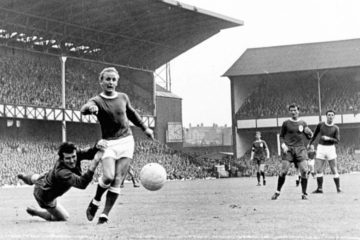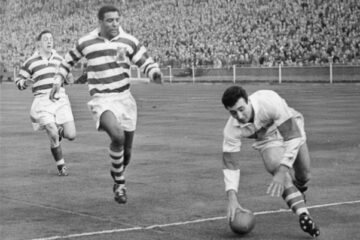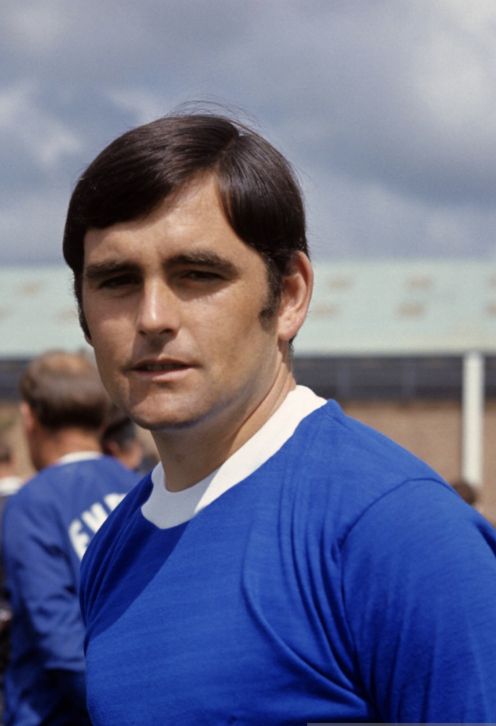
Gerry Humphreys was born in Llandudno in January 1946.
He started his education at a primary school called Ysgol Ffordd Dyffryn on West Shore, Llandudno.
When Gerry was only 8, his father spent almost twelve months in a sanitarium near Caernarfon, before succumbing to tuberculosis at the age of 34 yrs.
An early indicator of Gerry being a natural footballer was when he was selected for the school football team at the age of 9 when most of the team were two years older.
The older boys naturally had a stronger physique, but Gerry was never fazed as he just believed that playing the game was for him, regardless of the age or stature of the opposition.
His participation helped them win the primary school cup a year before furthering his education at Mostyn Secondary School.
Within a couple of years, Gerry was playing for the under 15’s team at the age of 13, helping them to victory in the Gillespie Cup which was open to all schools in the North Wales region, a feat that was repeated the following year.
Humphreys was also drafted in to the Clwyd and Conway County team at the age of 13. In one game they met their match facing Swansea boys who were a very good side, too good in fact for the North Wales outfit, knocking them out of the competition. Gerry was playing regularly as a striker and was a prolific goal scorer.
His performances in the Welsh counties caught the eye of the Welsh schoolboys, and finding him to be versatile, he was asked to play as a left winger. Humphreys appeared for the Welsh schoolboys at the Vetch Field, Swansea and Upton Park the home of West Ham United against England schoolboys. He also came up against the Scottish schoolboys at Kilmarnock’s Rugby Park.
Things continued to develop for Humphreys as he was spotted by Frederick Bennett, an Everton scout who lived along the Welsh coast in Bagillt.
Aston Villa and Leicester City were also very interested parties along with Nottingham Forest, who were willing to relocate Gerry and his mother to the Nottingham area. In addition, interest came locally from Llandudno FC who were desperate for his signature, as Gerry was attracting publicity in the local press. Further interest spread from the north west with Liverpool and Oldham Athletic being two known parties.
However Gerry was an Everton fan and once Bennett made him and his mother aware of his interest, Gerry needed convincing no further, and in the summer of 1960, Humphreys was invited to train at Bellefield. Everton were then managed by Johnny Carey, with Les Shannon in charge of the youngsters.
Gerry’s stay was for a week or so and he was put up in digs in Walton, accompanied by another Welsh youngster from Anglesey, called Owen Hughes, a goalkeeper. Gerry and Owen were no strangers to each other, having played together for the Welsh schoolboys.
Gerry featured at Wembley Stadium against England in the last year of his school days, before signing as an apprentice at his dream club in the summer of 1961.
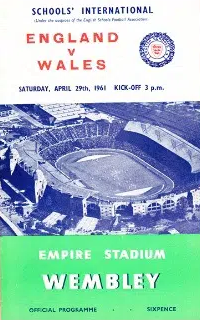

A change in personnel at the top saw the sacking of Carey with Harry Catterick installed as the new manager.
On joining Everton, Gerry was not alone, as four Liverpool born boys signed at the same time: Ken Mulhearn who later made the grade at Manchester City, Gary Coxon who joined Blackburn Rovers in 1963, and Tommy Wright, all defenders, plus Geoff Harcombe.
Gerry learnt his trade in the A and B teams in the Lancashire League. Whilst in the junior team Humphreys scored all 7 goals in a match against Preston North End and was rewarded by manager Harry Catterick inviting him to train with the first team.
He played for Everton Youth in their FA Youth Cup run of 1963/64. Everton hosted a “mini derby” in the second round on a bitterly cold night on 17 December 1963. John Hurst’s goal put the young blues into the next round and another home tie against Wigan Athletic.
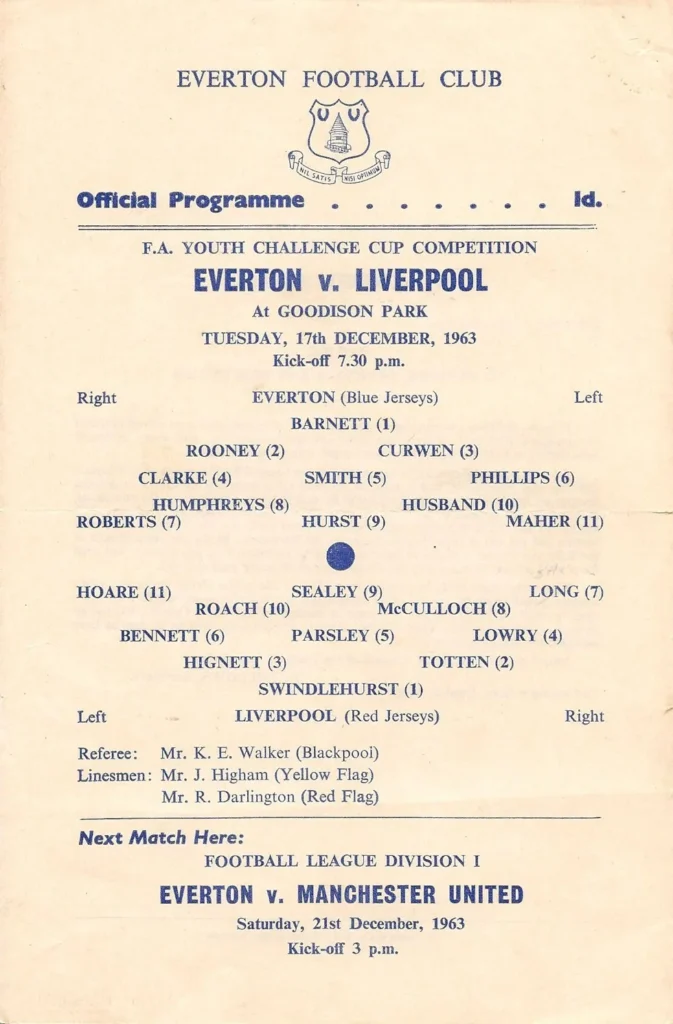
(Andrew Weir https://evertonfayouthcuphistory.webador.co.uk/)
Everton cruised into a four-goal lead after 20 minutes and a further two goals took them to the break 6-0 ahead. Aiden Maher, a John Hurst hat-trick and a brace from Humphreys put the game beyond doubt. A second half hat-trick from Husband, with Maher, Hurst and Humphreys all adding to their tallies completed the rout, giving Everton a 12-1 victory.
Humphreys missed the following round at home to Leeds United two days before Valentines Day and the youngsters’ hearts were broken as they lost by a single goal by Rod Belfitt who later joined Everton in 1972.
Humphreys meanwhile, was convalescing with the nuns at Gateacre Grange nursing home, recovering from a cartilage operation.
Regaining his fitness, his prolific goal scoring impressed the coaches elevating him into the reserve side in the Central League at the age of 17. He netted 12 goals for the reserves in the 1963/64 season, prompting the club to take him on the tour of Australia in 1964.
In the eight games that Everton played on that tour, Gerry found the net in the fourth game against an Australia XI hitting the first goal in a 3-0 win, with Mick Meagan and Derek Temple completing the scoring.
The season of 1964/65 saw Gerry continuing to score goals in the Central League with 15, including a hat-trick against Sheffield United at home in January 1965. Everton finished the season as runners up to Blackburn Rovers.
On 16 April 1966, Gerry finally made his debut for the senior team away at Leeds United’s Elland Road. Seven days later, Everton were to play an FA cup semi-final at Burnden Park, Bolton against Manchester United.
Harry Catterick fielded a weakened team at Leeds as the Central League side didn’t have a game that weekend. Gerry said in 2013; “We trained all week; the first-team had gone up to stay at a hotel in Harrogate. The next thing, the Central League players were told we were going to the game. We thought we were going to watch the match, but when we arrived, we saw the first-team squad getting on the team coach and leaving, and we were told to play”.
The Football League fined Everton a sum of £2,000 for not taking the fixture seriously.
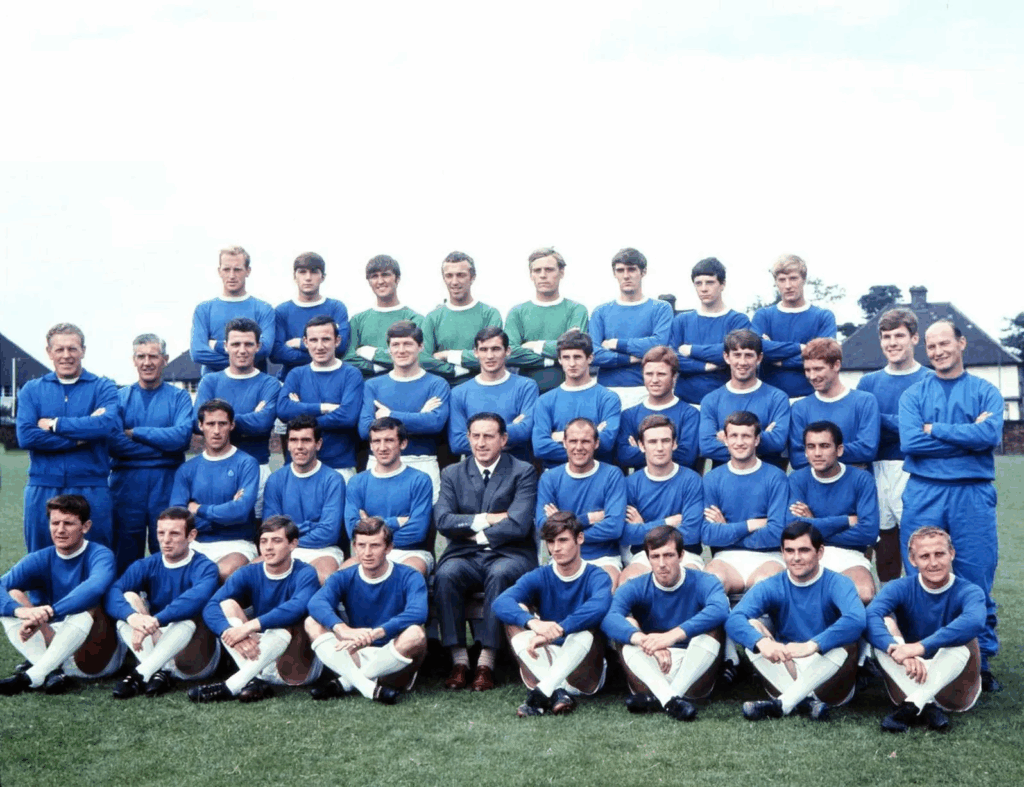
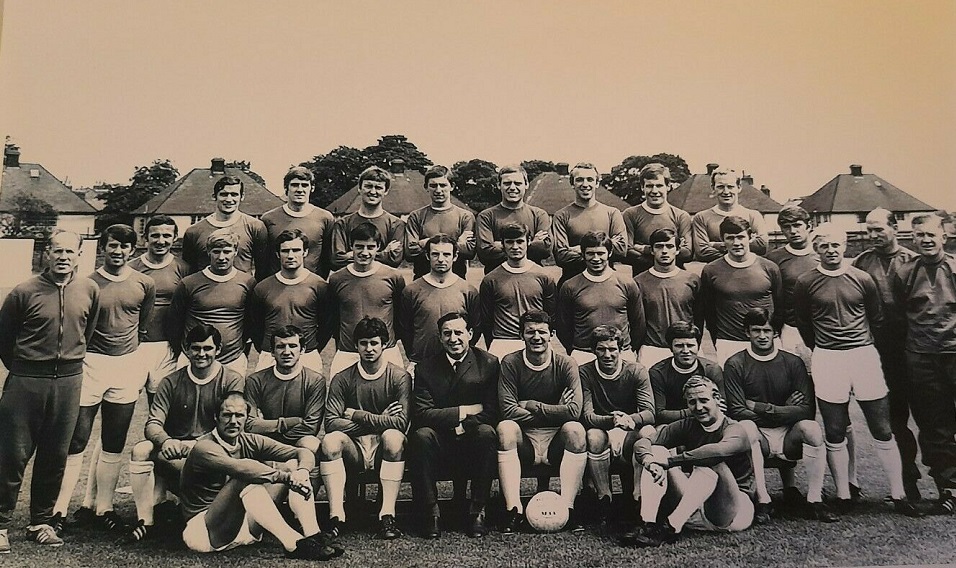
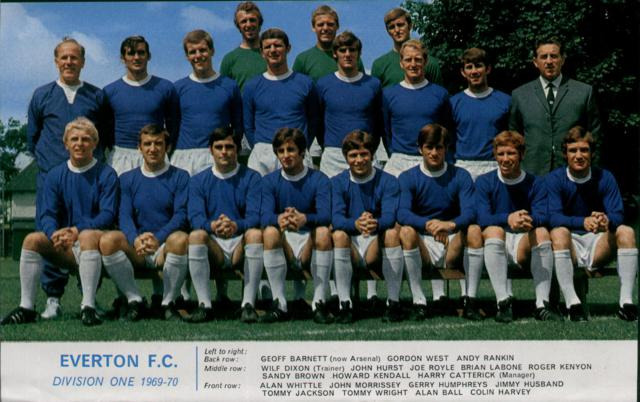
Gerry would often be included in the Everton party, before substitutes were introduced, without being selected.
On 14 September 1968, Humphreys scored his first goal in League football against Sheffield Wednesday. A goal described as one of the best ever scored in that famous old stadium.
Speaking again in 2013 he says; “That day I was playing on the left wing instead of Johnny Morrissey. I think the ball was slipped out to me by Alan Ball. I can’t remember if I took a touch before I hit it, or whether I just came on to it and hit it first time from about 25 yards. I was on an angle and it went straight across into the top corner. When I’ve gone to functions, fans always bring that up. I’m thrilled to bits that people still remember it. On another day, that effort would have probably gone over the bar. “
Confirming it was no fluke, Humphreys repeated the exercise 77 days later as Everton thumped Leicester City, again at Goodison, 7-1. A very raw Peter Shilton, Allan Clarke, David Nish and a few more household names turned out for the visitors that afternoon. The day started badly for the Foxes when manager Matt Gillies resigned before the game.
The goal? Talking us through it again in 2013 Gerry says; “Yes, I remember that well, it was into the Stanley Park End. Peter Shilton was in control of the ball and in those days, centre-forwards were allowed to stand in front of the keeper and try to stop him from kicking the ball up field. Joe Royle stood in front of the keeper, and for some unknown reason, Shilton panicked and threw it out, and conveniently to me. Leicester City used to wear blue when they played at home, so whether he got confused that day, I don’t know. But the ball ended up at my feet and he was way off his line, so I chipped him and it went into the far corner of the net. I was a good 25-30 yards out, as well.”
Humphreys was a predominantly right footed player but was also effective with his left. It was once stated by club physiotherapist Norman Borrowdale, that Humphreys was the best two footed player at the club. Gerry, as humble as he is, wouldn’t agree, saying that Johnny Morrissey had that accolade, even though he was equally proud to have been recognised in that way.
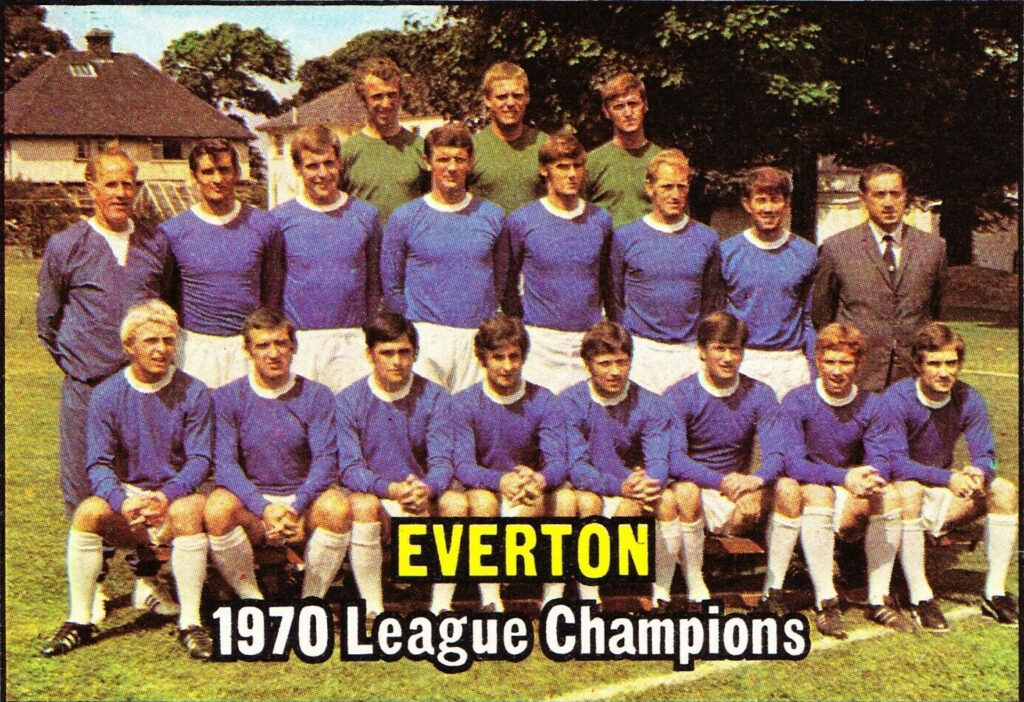
Gerry married his childhood sweetheart, Helen Jones at the Seilo Welsh Calvinistic Methodist Chapel on 7 June 1969. But the season that followed proved to be the last at Everton for the young Welshman, as with a year or so left on his contract, Gerry was made aware that Crystal Palace were keen to sign him, and he was advised by Everton that it was a good opportunity for him.
Crystal Palace manager Bert Head eventually convinced the youngster to sign, opening a new chapter for him at Selhurst Park.
He signed for the Eagles on 8 June 1970 for a fee believed to have been around £10,000. His debut came as a substitute at Anfield in the fourth game of the new season on Tuesday 25 August. Bobby Graham put the Reds ahead with a goal on the stroke of half-time. Humphreys replaced Tony Taylor at the break, and the visitors snatched a last-minute equaliser through Gerry Queen.
His full debut came in the League Cup second round, first leg in a home tie against Rochdale in September 1970. The game finished 3-3 with the Eagles winning the second leg comfortably 1-3. Gerry was an unused substitute in that game.
Humphreys was confined to the substitutes bench for most of the season making his full league debut away at Newcastle United on Saturday 19 December. The day was one to forget as Palace went down to a brace from Bryan “Pop” Robson.
Humphreys made three more starts that season making a total of four, plus seven substitute appearances. The signing of Jimmy Scott (the brother of Everton’s Alex) in January 1971 from Newcastle hindered Humphreys as both played in the same position. Gerry’s last involvement was on 13th March 1971, again as an unused substitute at home to Arsenal with the Gunners winning 2-0.
His move to SE25 lasted almost two years but Gerry failed to secure a regular first team place with promising youngsters breaking through from the Football Combination team, and with his contract closing he was told he was free to leave. In that time, Gerry and his wife Helen had become proud parents to their son John, born in December 1971 in Croydon.
Gerry had been featuring regularly for the reserves in seasons 1970/71 and 1971/72 until his move back north in January 1972. His last appearance for the reserves was on New Year’s Day away at Chelsea.
Having failed to even make the bench for the first team during the season of 1971/72, Crewe Alexandra manager Tom McAnarney made several trips to London with the hope of persuading Gerry to sign. Initially he wasn’t interested but as time went by, McAnarney finally convinced Humphreys to put pen to paper.
He made his debut at Gresty Road on 29 January 1972 when visitors Grimsby Town ruined his day with a 1-0 win. McAnarney’s stay however, was brief lasting a mere 9 months 16 days before the appointment of former Manchester United star Dennis Violett on an interim basis followed by the permanent appointment of former Liverpool player Jimmy Melia. Difficulty to sustain a comfortable league position resulted in the sacking of Melia in December 1973.
Gerry was voted the fans ‘Player of the Year’ in his first season and during his time at Gresty Road, the Alex enjoyed some magical moments, particularly in cup competitions, notably the League Cup as the minnows. Now managed by Ernie Tagg in his second spell as manager having previously been in the hot seat from November 1964 to October 1970, Crewe eliminated First Division Birmingham City 2-1 in the second round of the Football League Cup.
The following season, the Alex achieved another cup shock in Round Two, capturing a big scalp with Chelsea becoming the latest victims. Humphreys has become the regular penalty taker for the Railwaymen and succeeded once more with a penalty past Steve Sherwood to proceed into the next round
A spell of five and a half years at Gresty Road ended with Gerry and his family heading back home to North Wales where he started a new career as a taxi driver, an opportunity encouraged by his father-in-law, a retired policeman.
He also played part time for Rhyl spending only one season there.
Gerry represented Wales U23’s on five occasions with his debut at Ninian Park, Cardiff in February 1965.
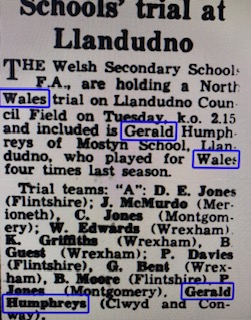
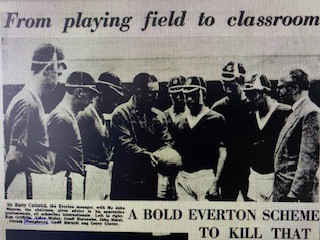
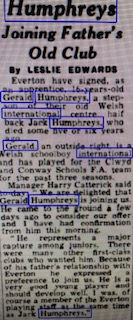
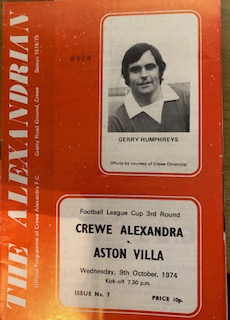
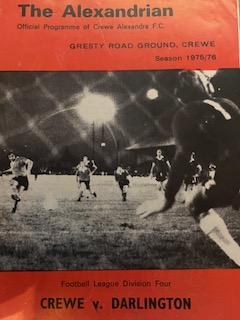
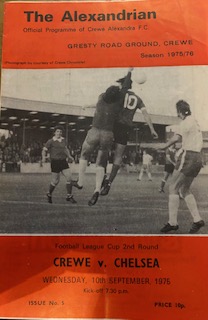
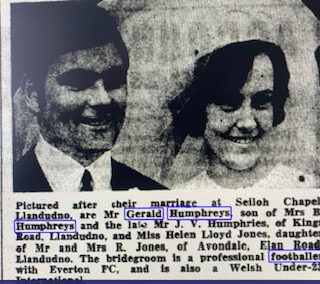
……………………………………………………………
Jack Humphreys
For a full article on Jack Humphreys, please click the link below to take you to Rob Sawyer’s account
On this website;
Rob Sawyer, Jack Humphreys – Blue Dragon (2017)
The story of the Welsh centre-half who at one time was keeping Goodison great T.G. Jones out of the Everton team.
And on ToffeeWeb;

